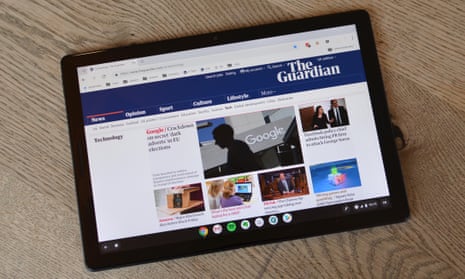The Pixel Slate is Google’s latest attempt to make a premium tablet, this time built around Chrome OS rather than Android, and it’s all the better for it.
The Guardian’s product and service reviews are independent and are in no way influenced by any advertiser or commercial initiative. We will earn a commission from the retailer if you buy something through an affiliate link. Learn more.
Google has made tablets before, with the most recent Pixel C being about as good as a Android productivity tablet gets, which is to say: nowhere near as good as a proper PC.
But Google has another operating system, Chrome OS, which started life as basically just the Chrome browser. Now it’s a light but powerful operating system, with Android and Linux app support.
The Pixel Slate is Google’s attempt to show that Chrome OS can pull double duty as both an entertainment tablet operating system and a serious desktop-class workhorse.
Simple design
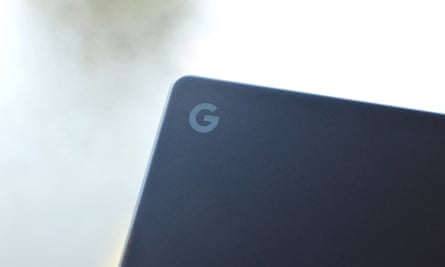
On the outside the Pixel Slate is about as simple as tablets get. The front is filled with a crisp and beautiful 12.3in high-density LCD screen that’s as good as you’d find on top-end laptops.
A relatively wide and uniform bezel frames the screen and houses a webcam in the top and a pair of fairly powerful stereo speakers in the left and right sides. The screen’s Gorilla Glass 5 rounds off into an aluminium body, which feels comfortable to hold for extended periods.
Flip the tablet over to find the dark blue aluminium back is oddly featureless, marked only by a subtle “G” logo in top left corner and a camera in the top right.
The bottom of the tablet has a magnetic connector for slotting into the keyboard case, while the power button in the top left doubles as fingerprint scanner and works well.
The Pixel Slate is 7mm thick, which is 1.5mm thinner than Microsoft’s Surface Pro 6, but 1.1mm thicker than the new 12.9in Apple iPad Pro. The Google tablet weighs 726g, which is 50g lighter than the Surface Pro 6, but almost 100g heavier than the iPad Pro. The Pixel Slate is thin and light for a PC, but bigger and heavier than most media tablets.
Specifications
Screen: 12.3in Molecular Display LCD 3000x2000 (293 ppi)
Processor: Intel Celeron or Core m3, i5 or i7 (8th generation Y-series)
RAM: 4, 8 or 16GB
Storage: 32, 64, 128 or 256GB
Operating system: Chrome OS
Camera: 8MP front facing and 8MP rear camera
Connectivity: Wifi ac, Bluetooth 4.2, 2x USB-C
Dimensions: 202 x 290.9 x 7mm
Weight: 726g
PC hardware
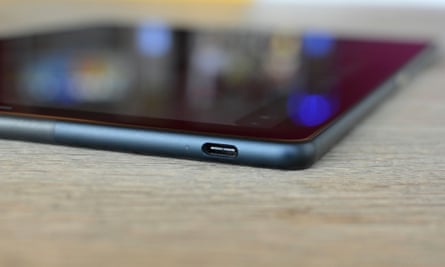
The model tested had a 1.3GHz Intel Core i5 (8200Y) processor, 8GB of RAM and 128GB of storage.
The point of Chrome OS is that it provides a good experience on cheap, low-end hardware. Give it relatively powerful components and it absolutely flies.
The Core i5 version tested handled everything you can do with Chrome OS with aplomb. No amount of Chrome tabs brought it to a crawl. Heavy duty web apps, such as content management systems and other tools, flew. You can run as many extensions as you like with Chrome with no noticeable performance impact.
All the Android apps ran as fast as they would on a modern smartphone too, including games such as Shadowgun Legends, although the tablet reached around 50C at its peak and felt pretty hot to touch.
Battery life was excellent for a work tablet, lasting close to 10 hours between charges when used like a laptop, with 10 or so Chrome tabs open alongside various chat, imaging and media apps.
Opening up the machine at 9am, the Pixel Slate would last all the way through the heaviest of work days and still have enough charge for a movie on the way home.
It’ll charge via either of the USB-C ports in the left and right sides, and took about two and a half hours to fully charge from flat while being used.
Chrome OS
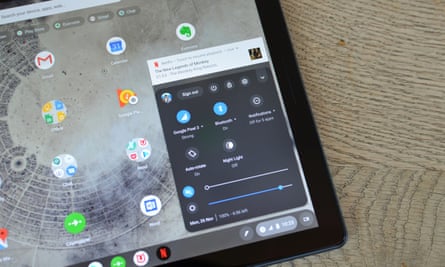
On the face of it, the predominantly mouse and keyboard-driven Chrome OS appears an odd choice for a tablet, but over the past few years Google has pushed Android app integration and made lots of touch-centric tweaks.
Chrome OS on the Pixel Slate has two modes: a desktop experience enabled when you attach a keyboard and mouse, and a Android-like tablet mode when used on its own.
Keyboard attached
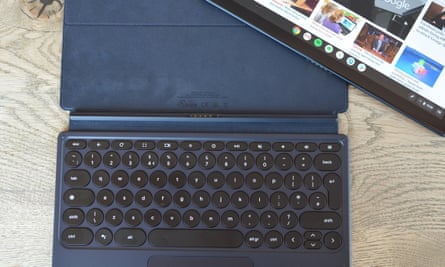
As a desktop the Pixel Slate behaves like any modern Chrome OS device. A shelf at the bottom of the screen shows your pinned and running app icons, there’s a start-menu-like “launcher” button in the bottom left and a system tray in the right with an Android-like notification shade. Apps open as windows, and can be arranged however you like.
Press the launcher button and up pops a search box and some AI-powered app suggestions for what you might need at that moment. Swipe up or press the up arrow to see all your apps, or just start typing to find an app, file or to search the web. It’s a familiar experience for anyone who has used Windows 10 or MacOS.
As a tablet
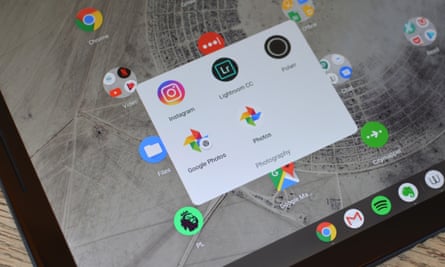
Grab the tablet on its own and the interface switches to look like Android with the launcher becoming the homescreen filled with apps and folders. A back button appears in the bottom left and the overview button in the bottom right.
Tap an app from the homescreen and it launches in full-screen. The dock stays at the bottom of the screen with pinned and currently running apps. Hit the overview button to zoom out and see running apps in a screen that looks like the multitasking view from MacOS or Android, which is where you can jump into another app or run two side-by-side in splitscreen.
Scrolling with your finger is super smooth, as are the animations, while bigger tap targets and familiar swiping gestures make it feel much more a mobile tablet. But this is still full Chrome, not a cut-down mobile version, giving you the best, most powerful browsing experience on any platform. It’s a joy to use.
Android apps are a bit more of a mixed bag. Most run as they do on a real Android tablet but some have quirks, such as Citymapper and Wire refusing to run in landscape.
Netflix works fine, but even it has oddities such as failing to recognise an ethernet connection as akin to wifi, meaning you have to uncheck “download only on wifi” to store shows offline.
Sky’s Q app also crashes while streaming TV, sending you back to the media select screen periodically. As far as Android app support on Chrome OS has come, it’s still a work in progress.
Pixel Slate Keyboard
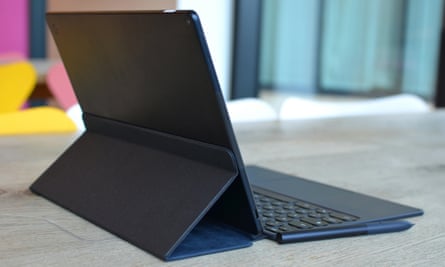
The Pixel Slate keyboard has one of the best typing experiences I have used, with backlit keys, solid travel, good feel and spacing. The only thing missing are delete and track skip media buttons, but these are minor quibbles. The large, smooth and responsive trackpad is good too.
The keyboard attaches to the bottom and back of the Slate via reassuringly strong magnets, holding it at a relatively large range of viewing angles – far better than most other folding folio-style tablet stands.
Unfortunately when closed the keyboard side slides around against the screen, which might end up scratching the display and feels less than reassuring when carried.
Pixelbook Pen
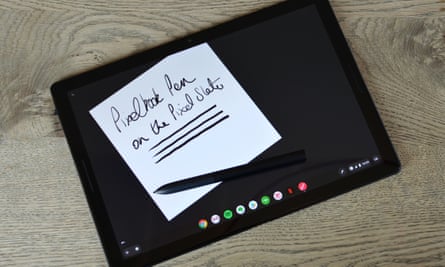
The Pixelbook Pen is the same stylus that launched with the Pixelbook last year, with Google Assistant features and a solid on-screen writing experience with low lag, tilt and pressure sensitivity.
It’s a bit thick and unbalanced for my liking, but is useful for signing documents or making quick sketches. I don’t think it’s a must-buy with the Pixel Slate, but then I’m not trying to use it for illustration or design.
Annoyingly there’s nowhere to reliably attach it to the tablet or the folio keyboard, so the potential for losing it is high.
Observations

The USB-C ports handle any number of peripherals, including external monitors, storage and headphones with an adaptor (there’s no headphone jack)
Chrome OS lacks spell check in most Android apps and there’s no autofill capability using apps such as LastPass
The Pixel Slate’s balance point is right in the middle of the tablet, which is also where the hot components are making the tablet feel cool while being held
Price
The Google Pixel Slate comes in various processor and memory configurations starting at £549 with an Intel Celeron processor, 4GB of RAM and 32GB of storage or £649 for 8GB of RAM and 64GB of storage.
Variants with eighth-generation Intel processors start at £749 with a Core m3, 8GB of RAM and 64GB of storage, £969 for a Core i5, 8GB of RAM and 128GB of storage and topping out at £1,549 for a Core i7, 16GB of RAM and 256GB of storage.
The Pixel Slate Keyboard costs £189 and the Pixelbook Pen £99.
For comparison, the Microsoft Surface Go starts at £379, the Surface Pro at £879 and Apple iPad Pro at £769.
Verdict
The Pixel Slate makes a very convincing argument for the death of Android tablets. Turning the desktop-class experience of Chrome OS into a mobile, finger-friendly operating system brings the best of both worlds together in one neat package. At least in theory. Most of it works really, really well. But it is a case of trial and error for Android apps to see what works and what doesn’t.
If you need to get stuff done, and you primarily do so in a browser with additional little bits of software such as Evernote, chat apps or the like, the Pixel Slate is a productivity powerhouse when in laptop mode. The Keyboard folio is therefore an essential purchase adding £189 to the cost of the machine.
But I was pleasantly surprised by how good the tablet experience was on the Pixel Slate. There are quirks, a few apps need a bit of work, and a few things are missing from the standard Android experience, but having a thoroughly touch-adapted desktop-class Chrome at your fingertips is wonderful. The Pixel Slate offers the best, most powerful browsing experience of any device.
Chrome OS is still a work in progress and there will be the occasional thing you’ll still need a full Windows PC to do, but what the Pixel Slate offers already is worth buying if you want to be on the bleeding edge. Just don’t expect every app and game to offer the most polished experience despite the premium price.
Pros: long battery life, the best browsing experience, great screen, good keyboards, frequent software updates, USB-C
Cons: some apps behave weirdly, Chrome OS still can’t do everything a Windows PC can, expensive

